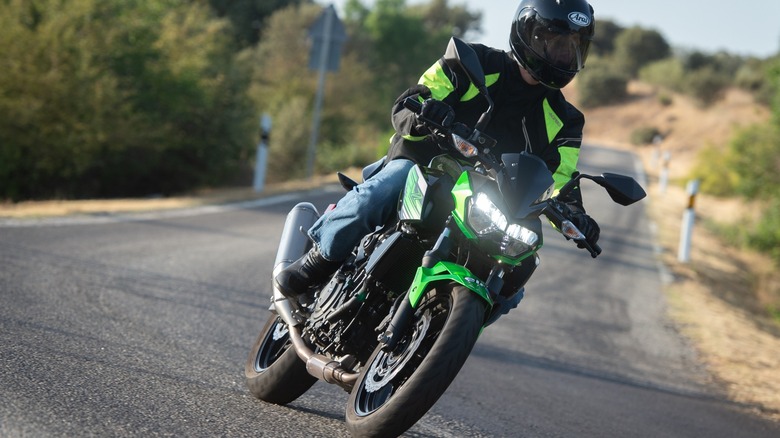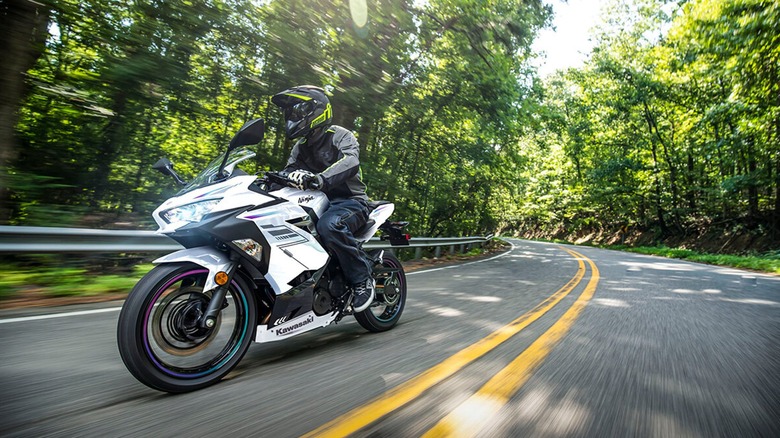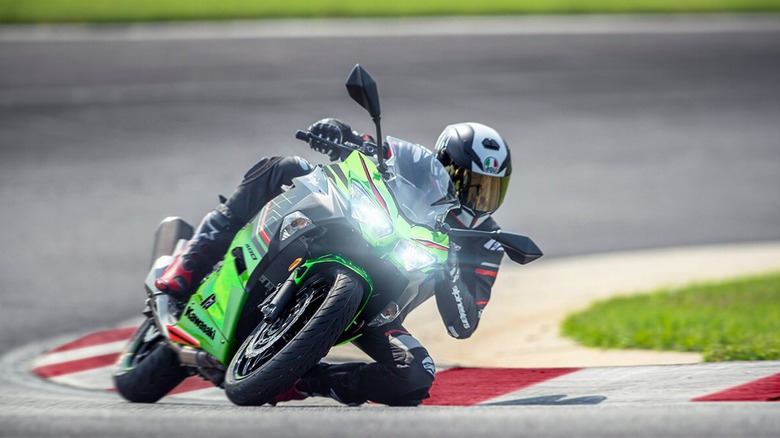What Does Kawasaki's 'KRT Edition' Mean And How Is It Different From The Ninja 400?
The Kawasaki Ninja motorcycle line is celebrating 40 years of performance in 2024. Ninja sport bikes carry a reputation as dependable, well-rounded street bikes with displacements ranging from 400cc to 1,441cc, and there's even the electric Ninja e-1. If you are just starting to learn to ride, the Ninja 400 is a good bike for beginners. While perusing Kawasaki's Ninja 400 online, you may notice there are two versions of the 400 that, on the surface, appear to be the same motorcycle.
The first Kawasaki Ninja 400 option on the list has prices for the non-ABS model ranging from $5,299 to $5,499 and the ABS version from $5,699 to $5,899. Scrolling down the page a little farther reveals the Ninja 400 KRT Edition that's priced the same as the top values for the non-ABS and ABS versions of the non-KRT Edition. We'll use Kawasaki's specifications and online Build and Price tool to get to the bottom of this and see what's actually different between the two Ninja 400 models.
The Kawasaki Ninja 400
The Kawasaki Ninja 400 is fast enough for a sport bike, featuring a liquid-cooled, two-cylinder engine. The Ninja 400's actual displacement measures 399cc with its 70.0mm (2.75-inch) bore parallel-twin cylinders and 51.8mm (2-inch) crankshaft stroke, and the dual overhead cam (DOHC) four-stroke engine provides plentiful power and low-end torque thanks to its 11.5:1 compression ratio, electronic ignition, and six-speed transmission.
The Ninja 400 provides a choice of braking systems. The ABS, or anti-lock braking system, works like the ABS system in your car by monitoring both front and rear wheel speeds and modulating brake fluid pressure as needed to prevent the tires from skidding and losing control. The non-ABS version requires the rider to modulate braking pressures manually through the front brake lever or the rear brake pedal. Both systems employ disc brakes with a 310mm (12.2-inch) semi-floating disc and two-piston calipers at the front and a 220mm (8.66-inch) petal-type disc with a single-piston caliper at the rear.
The price range for the standard Ninja 400 results from choosing one of the three color scheme options. The cheapest option at $5,299 is the Metallic Matte Carbon Gray over Metallic Carbon Gray. Premium color options increase the price by $200 and include Metallic Carbon Gray over Pearl Blizzard White and Metallic Matte Twilight Blue over Metallic Magnetic Dark Gray.
What's different about the Ninja 400 KRT Edition?
Comparing the two Ninja 400 trims, at first glance it appears the Ninja 400 KRT Edition's only difference is its color scheme and graphics inspired by the Kawasaki Racing Team (thus the KRT designation). According to Kawasaki's online Build and Price tool, the Ninja 400 KRT Edition is only available in the Ebony over Lime Green color scheme associated with Kawasaki racing bikes.
Like the standard Kawasaki Ninja 400, the KRT Edition is available with conventional or ABS braking systems. Since both versions feature the same specs for the engine, drivetrain, brakes, and dimensions, is the KRT Edition simply another color option for the standard Ninja 400? After taking a deep dive into Kawasaki's specifications, there is one other difference.
Besides color options, the difference between the standard Kawasaki Ninja 400 and the Ninja 400 KRT Edition is the rear tire size. According to Kawasaki, the KRT Edition Ninja 400 uses a 150/60-17 rear tire compared to the 150/70-17 on the base model. While that might not appear to be a significant difference, the KRT Edition tire is over an inch smaller in diameter, a difference of 4.7 percent. On the road, that means the smaller diameter tire has to make an additional 39 revolutions per mile.
The most logical reason for Kawasaki opting for the smaller diameter tire on its racing-inspired Ninja 400 KRT Edition is for the effect it has on the gear ratio. Using a smaller tire is a simple method for achieving a lower gear ratio, giving the bike more low-end power without changing the transmission or sprockets.


